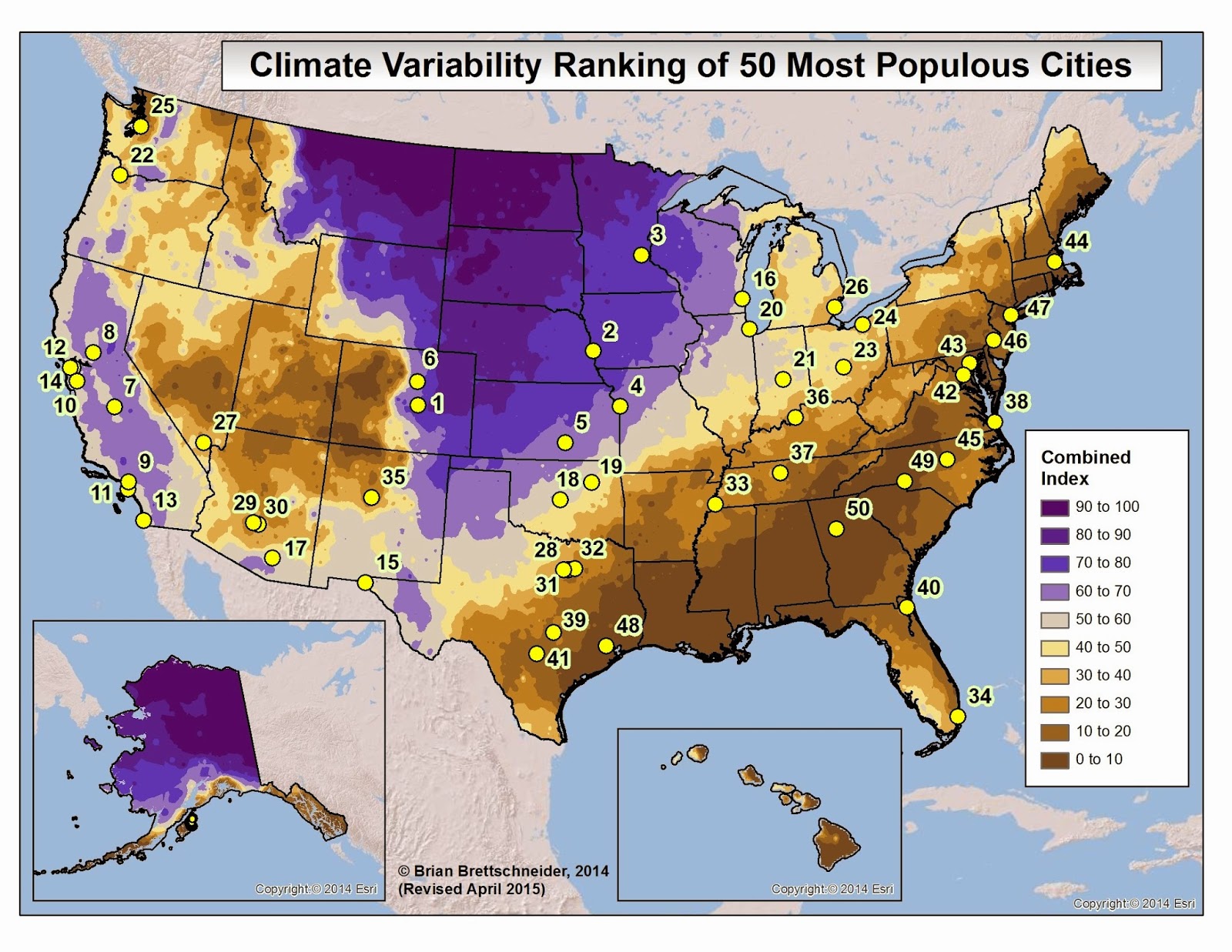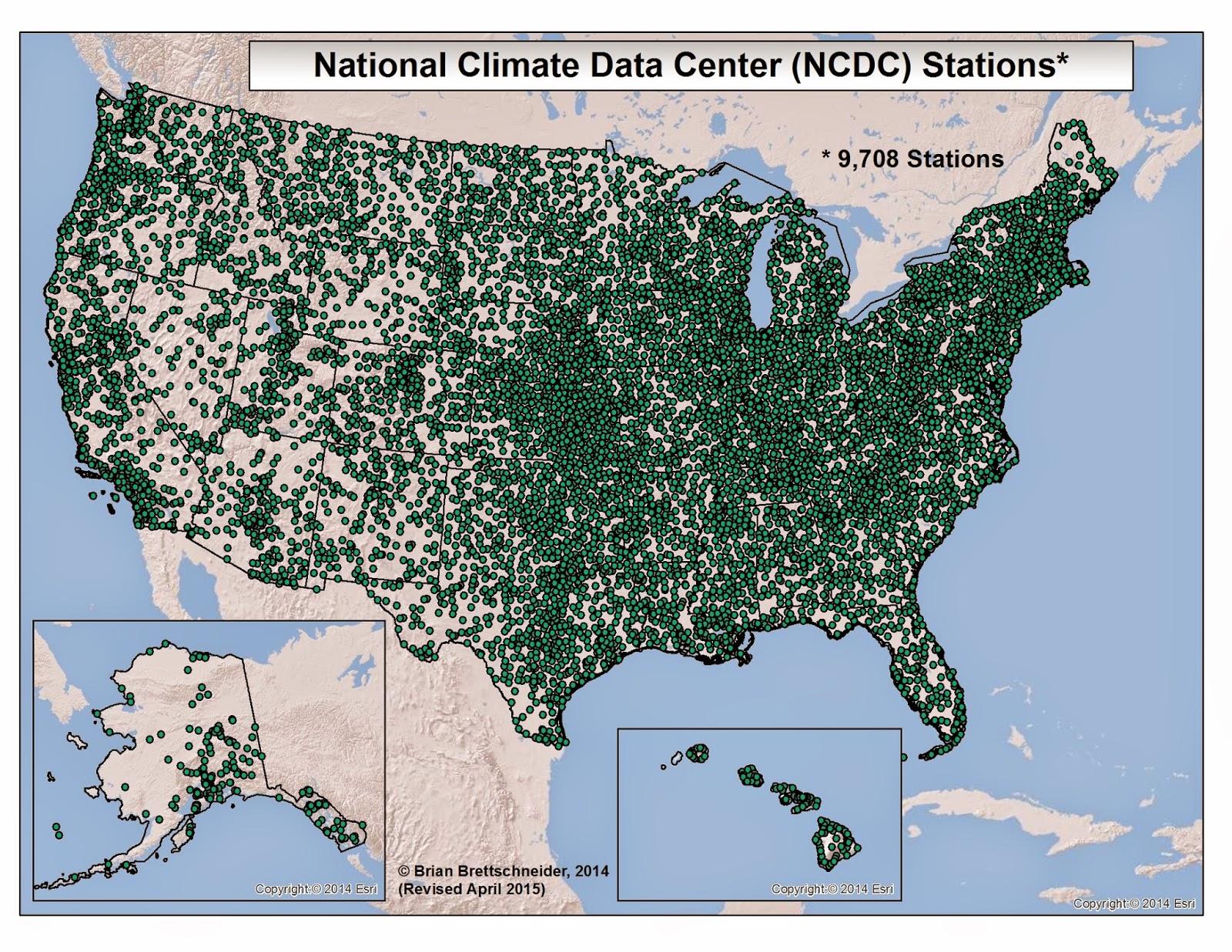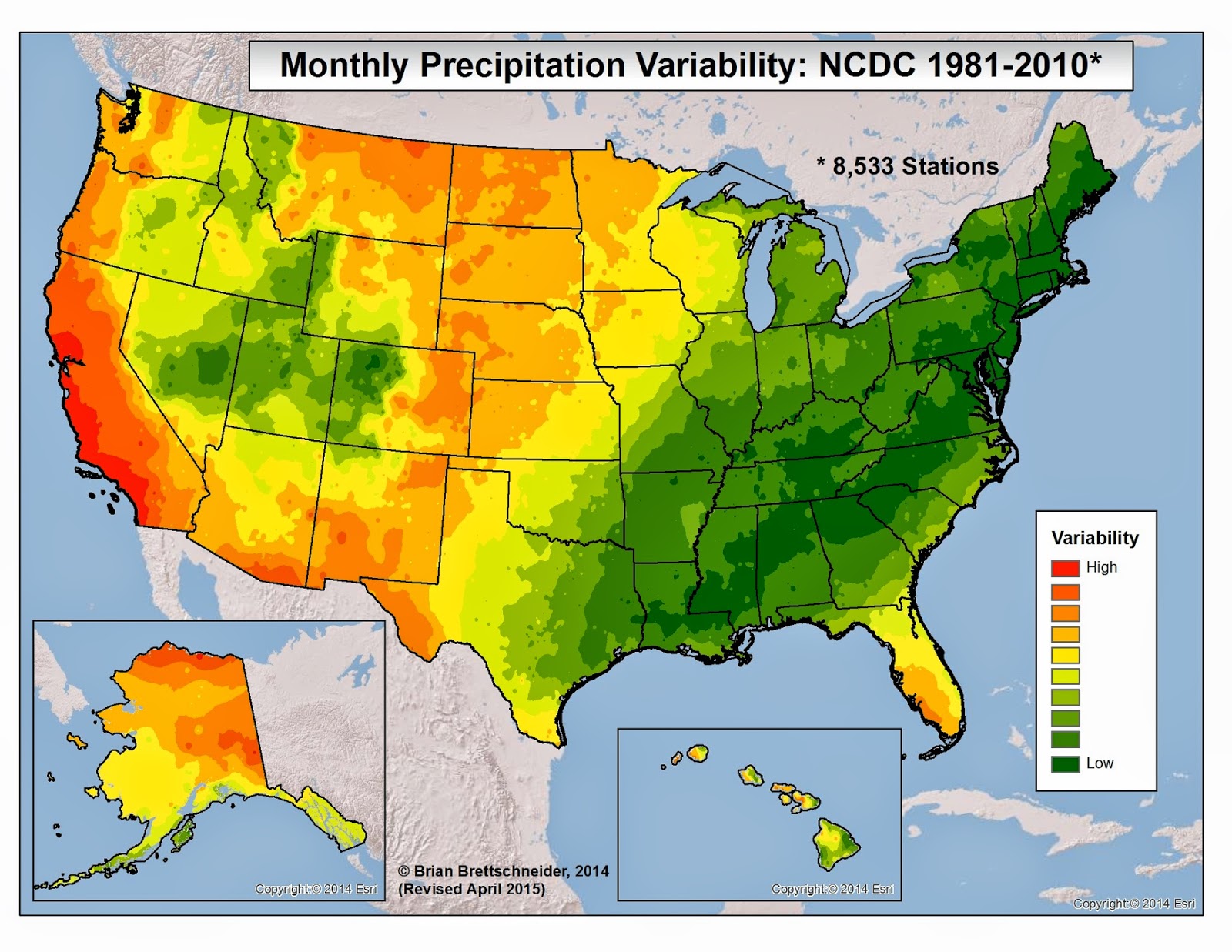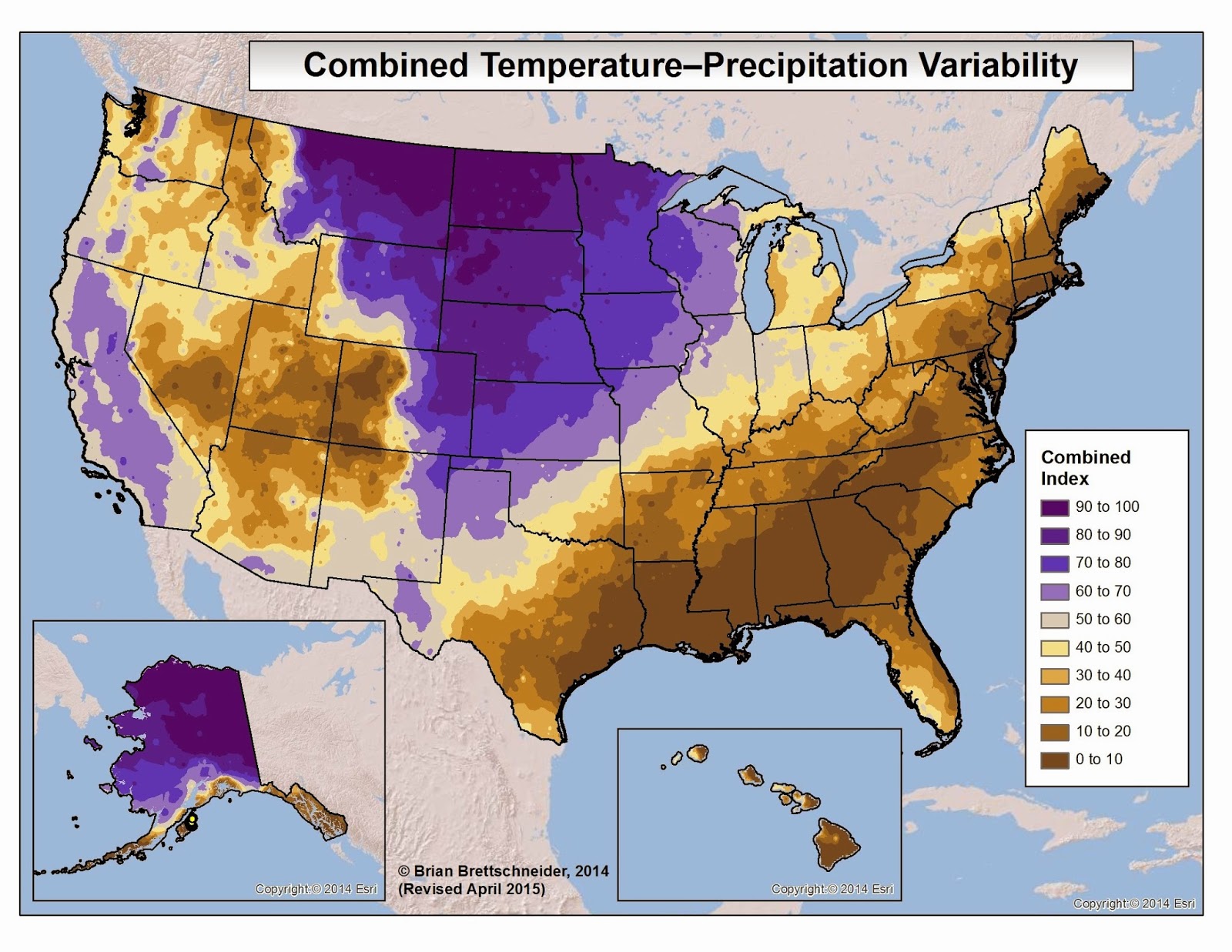After an e-mail conversation with Dr. Randall Osczevski, one of the researchers that developed the 2001 revised wind chill formula, it is possible (likely ?) that the Feb 21, 2013, low wind chill event at Howard Pass was even lower than the January 2004 value from Mt. Washington. This makes it a VERY UNOFFICIAL United States low wind chill record.
Dr. Osczevski noted that the wind chill formula assumes a 1/3 speed reduction from a ~10 m wind sensor. Since the Howard Pass wind sensor is at 3 m, the 10 m wind would actually be about 1.28 higher than the 3 m wind. The low wind chill at Howard Pass of -99.8°F on 2/21/2013 was with a temperature of -47.5°F and a sustained wind of 53.7 mph. If we adjust the wind by a factor of 1.28, the 10 m wind speed value is 68.7 mph. That would yield a new low equivalent wind chill of -105°F. This eclipses the Mt. Washington low wind chill of -102.6°F (using tenths for temperature and wind). Mt. Washington uses a 10 m wind sensor.
**************************
** Original Blog Post Below
**************************
On February 14, 2014, a remarkable event occurred along the northern slopes of the Brooks Range above the Arctic Circle. Namely, a purported wind chill of -97°F was observed by an automated wind instrument located at Howard Pass operated by the National Park Service. The station is part of the Remote Automatic Weather Stations (RAWS) network and is referred to as Howard Pass RAWS. This event was well publicized by the National Weather Service (NWS) as a possible state and national record. Both Alaska and national newspapers carried the story and for a few days it generated a fair amount of discussion nationally. Unbeknownst to all but a handful of people at the time was an even lower wind chill recorded at the same station one year earlier. This earlier event was unknown at the time of occurrence due to the malfunctioning of transmission equipment. The onsite data logger continued to function during the event and when the data were retrieved several months later, the dramatic observations were revealed.
At 10 p.m. on February 21, 2013, a 2-meter air temperature of -47.5°F was observed along with a sustained wind of 53.7 miles per hour at the Howard Pass RAWS weather station. The combination of these two meteorological conditions produced a staggering wind chill of -99.8°F! The following sections of this report describe the setting where the station is located and the meteorological conditions present at the time.
Howard Pass
The Howard Pass area is currently uninhabited but indigenous people have occupied the region for thousands of years. The pass is an important caribou migration corridor and hence historic and prehistoric hunters utilized this location for subsistence and other traditional activities. The National Park Service participates in a program to establish and maintain weather stations in remote sections of Alaska on their land holdings. Howard Pass is within the six million acre Noatak National Preserve, created in 1980 by the Alaska National Interest Lands Conservation Act (ANILCA). The Noatak National Preserve is managed by the National Park Service and part of the justification of the Preserve's establishment was to promote scientific research in the area (ANILCA Section 102 (8)(a)). The National Park Service decided in 2007 to place an automated station at Howard Pass for the following reasons: 1) there are no nearby stations, 2) it is a major caribou migratory corridor, and 3) there are significant archaeological resources in the pass. This site location is also more accessible by helicopter than the pass itself due to the boggy nature of the pass.
The Howard Pass RAWS station is located at latitude 68.156°N, longitude 156.895°W, and at an elevation of 2,062 feet in the northwestern Brooks Range of Alaska. The station sits near the top of a hill on the eastern flank of the pass approximately 300-400 feet above the pass level and is approximately 12 miles south of the northern limit of the Brooks Range and 85 miles north of the southern limit. The station was placed above the pass level to prevent migrating caribou from damaging the station. Figure 1 shows a map of the station’s location and Figure 2 shows an exaggerated relief map of the area. Figure 3 shows a picture of the station.
Figure 1. Howard Pass RAWS station location in northern Alaska. Image is a screenshot from Google Earth.
Figure 2. Howard Pass RAWS station vertical relief. The viewpoint of the image is facing north-northeast. Image is a screenshot from Google Earth.
Figure 3. Photograph of Howard Pass automated weather station looking toward the south. Image courtesy Ken Hill.
The station’s location makes it extremely susceptible to both low temperatures and strong winds. Each of the winter months has an average temperature between +5°F and -10°F and an average wind speed between 17 and 25 miles per hour. Figure 4 shows the monthly averages between 2011 and 2014. Just looking at the month of February, the combination of temperature and wind produces a month-long average wind chill of -36°F!
Figure 4. Monthly average temperature and wind at the Howard Pass RAWS station (2011-2014).
All of northern Alaska is characterized by long, severe winter conditions. Snow lies on the ground from October through May and temperatures are below zero for nearly one third of the year. The passes of the Brooks Range are also subjected to intense winds that are funneled through topographically constrained areas. The cold, dense nature of the airmass facilitates a semi-permanent inversion layer that provides a vertical constraint on the wind movement. The combination of the horizontal constriction due to topography and vertical restrictions due to an inversion layer causes tremendous winds to occur when very low temperatures are present and a north-to-south pressure gradient exists. This setup frequently produces exceptionally low wind chill values.
February 21, 2013
If you only had a satellite image to look at, nothing about February 21, 2013, would stand out. The MODIS satellite image from this date (see Figure 5) reveals nothing out of the ordinary. The entire region is snow covered and few, if any, clouds are present.
Figure 5. MOSIS Natural Color (12:43 p.m. Alaska Standard Time on February 21, 2013). Image area is approximately 105 x 70 miles.
What does not show up in the MODIS image is the dynamic nature of the atmosphere. The map shown in Figure 6 is a plot of surface weather conditions at 9 p.m. on February 21, 2013, from the Weather Prediction Center (WPC). A strong area of high pressure is centered far to the north of Alaska while a strong low pressure system was present in the Gulf of Alaska. These two features generated a tight pressure gradient resulting in strong winds across the northern one third of the state. Also evident are low temperatures and strong northeast winds.
Figure 7 is a map of temperature and wind chill values at 10 p.m. on February 21, 2013. The map illustrates the intensity of the cold air and the severity of the wind chill at the peak of the event. Many stations reported wind chills in the -40°s, -50°s, and -60°s. Anaktuvuk Pass, in the central Brooks Range, reported a wind chill of nearly -70°F. At this same time, the Howard Pass RAWS station reported a wind chill of -99.8°F.
Figure 6. Surface map of Alaska on February 21, 2013 at 9 p.m. Alaska Standard Time (AST). Map courtesy of the Weather Prediction Center.
Figure 7. Temperature and wind chill values reported on February 21, 2013, at 10 p.m. Alaska Standard Time (AST).
We should note that this was not a short-lived event. For the 9-day period between February 15, 2013, and February 24, 2013, the 2-meter temperature at Howard pass averaged -32.6°F and the 3-meter wind speed averaged 33.1 miles per hour (mph). The average wind chill during those 9 days was -71°F. Figure 8 shows the temperature and wind chill for Howard Pass RAWS during the time period described above.
Figure 8. Hourly temperature and wind chill values observed at the Howard Pass RAWS station between February 16, 2013, and February 24, 2013.
For nearly 48 hours, the wind chill at Howard Pass RAWS oscillated between -90°F and -100°F – with the peak value of -99.8°F reported at 10 p.m. on February 21st. During those 48 hours, the average temperature was -45.1°F and the average wind speed was 49.1 mph. We should note that Howard Pass has reported winds in excess of 80 mph on numerous occasions. The event of February 2014 that produced a wind chill of -97°F included a stretch of time with temperatures in the -30°s and sustained winds up to 90 mph. Interestingly, once wind speeds exceed 50 mph, wind chill values do not change very much. Figure 9 shows the conditions observed at Howard Pass during the low wind chill event of February 2014 that produced a minimum reading of -97°F.
Figure 9. Hourly temperature and wind chill values observed at the Howard Pass RAWS station between February 11, 2014, and February 15, 2014.
Station Equipment
Is a -99.8°F wind chill even possible or should we immediately treat the observations as suspicious and figure out what went wrong? Let us first look at the equipment present at the site (also see photograph in Figure 3).The following bulleted points were relayed from National Park Service staff:
- Station installation date: 7/13/2011. Station blew over on 8/16/2011 and was not repaired until 7/16/2012. Most sensors were not operating correctly August 2011 - July 2012.
- There are two air temperature sensors at the station. The primary sensor is a YSI ThermX and the backup sensor is a Vaisala HMP155. For the period 2011 through July 2013 the backup sensor (Vaisala) was transmitting instead of the primary sensor (YSI).
- The transmitting air temperature sensor (Vaisala) failed on August 3, 2012 and was not repaired until summer 2013. During the summer 2013 field visit, the primary sensor data were recovered from the data logger.
- Additional air temperature sensor information:
- Model YSI 44211
- Height: 2.0 meters
- Linear Range: -55°C to +85°C
- +/- 0.18° at -55°C
- +/- 0.02°C at +85°C
- Additional wind sensor information:
- Model RM Young 05103
- Height 3.0 meters
The station is clearly located in an exposed area. Strong winds have disabled the station several times in the past and have sand-blasted the equipment. This alone lends credence to extreme wind observations. Nothing in the list of station equipment though stands out as a disqualifier for any observations.
Event Reconstruction
To look at the plausibility of this event, we conducted a model simulation using the Weather Research and Forecasting (WRF) model for the time period in question. The model was initialized using February 21, 2013, 0.5°GFS data from 00:00 UTC. A recursive, nested grid structure of 27-9-3-1 kilometers were modeled over a 96-hour period. The model uses 30 arc-second topography – equivalent to 1 square kilometer grid cells – to represent the terrain.
The model showed very cold temperatures, strong winds, and very low wind chills during the time period in question. Figure 10 shows the estimated temperatures for the portion of the model area centered on Howard Pass. Cold air is clearly advected part of the way through the pass. The temperature only drops about 5°F in the 12 miles from the northern entrance of the pass until the weather station.
Figure 10. WRF model estimated temperatures for February 21, 2013, at 10 p.m. Alaska Standard Time (AST). Model initialized at 2/21/2013 at 0 UTC. Scene is 156 kilometers wide. Inner box contains 1.3 km grid cells. Areas outside of box contains 4 km grid cells. Units are degrees Fahrenheit.
Figure 11 shows the modeled sustained wind speed. The wind was only estimated to be around 35 miles per hour through the pass. Note how tightly packed together the wind streamlines are. There is a rather large discrepancy between the observed wind speeds and the modeled wind speeds. The hill where the station resides is not accounted for in the rather coarse (1 km) topographic dataset that the model uses. Interestingly, the model predicts an increase in winds of 5-10 miles per hour 100-200 meters above the pass level. Since the hill where the station is located is about 100-200 meters above the pass level, this is a reasonable, but still too low, proxy estimate for the wind speed at the station location. Figure 12 shows the modeled vertical wind profile for the station’s location.
Figure 11. WRF model estimated sustained winds for February 21, 2013, at 10 p.m. Alaska Standard Time (AST). Model initialized at 2/21/2013 at 0 UTC. Scene is 156 kilometers wide. Inner box contains 1.3 km grid cells. Areas outside of box contains 4 km grid cells. Units are miles per hour (mph).
Figure 12. WRF model estimated vertical wind profile for February 21, 2013, at 10 p.m. Alaska Standard Time (AST). Model initialized at 2/21/2013 at 0 UTC.
Finally, Figure 13 shows the wind chills for the portion of the model area centered on Howard Pass. There are several black regions at the northern entrance of Howard Pass. Those grid cells represent wind chill values between -90°F and -95°F. These are the lowest values for any portion of the model domains. At the location of Howard Pass RAWS, the estimated wind chill was -85.4°F. As noted in the earlier paragraph, the model’s elevation dataset is not detailed enough to represent this area of complex topography.
Figure 13. WRF model estimated wind chills for February 21, 2013, at 10 p.m. Alaska Standard Time (AST). Model initialized at 2/21/2013 at 0 UTC. Scene is 156 kilometers wide. Inner box contains 1.3 km grid cells. Areas outside of box contains 4 km grid cells. Units are degrees Fahrenheit.
Overall the model did a reasonable job of representing this event with the exception of under forecasting the winds. Table 1 summarizes the difference between the actual observations and the model estimates. We suspect that with a higher resolution topographic dataset, the modeled wind speeds would approach the observed wind measurements.
Table 1. Comparison of modeled and observed conditions on February 21, 2013, at 10 p.m. Alaska Standard Time (AST).
Wind Chill Record
Is the -99.8°F wind chill a record? The -97°F wind chill from February 2014 was informally determined to be a statewide and a national record. Unfortunately there is no database of lowest wind chill readings. The National Climate Data Center (NCDC) does not track low wind chills as part of their state or national records database. The Mount Washington (New Hampshire) observatory recorded a wind chill of -102.6°F on January 16, 2004, when the temperature was -41.8°F and the wind was 87.4 mph. It is unlikely that a lower wind chill has been measured at a long-term station in the U.S.
Back in 2001, the National Weather Service (NWS) adopted a new formula for computing wind chill values. Prior to 2001, wind chill values as low as -120°F were observed at several location. However, the “new” formula generally has higher (warmer) wind chill readings that the “old” formula given the same temperature and wind speeds. When those older observations were evaluated with the new formula, they all came back in the -90°s range.
So what is the lowest reading and what criteria are used? Would you believe that the previous low wind chill reading in Alaska was also -99.8°F? The city of McGrath, Alaska, reported an air temperature of -72°F and a wind speed of 7 mph on January 27, 1989. Plugging these numbers into the wind chill formula gives us the -99.8°F value. Figure 14 shows the minimum wind chills in Alaska during the great January 1989 cold snap. All values were rounded to whole numbers – hence the -100°F value shown for McGrath. Figure 15 shows the hourly observations at McGrath on January 27 and January 28, 1989.
Figure 14. Minimum wind chills in January 1989 for all stations in Alaska that reported hourly observations. For some stations, many observations are missing so a few data points should be considered suspect.
Figure 15. Hourly temperature and wind speed for McGrath, Alaska, on January 27 and January 28, 1989. Both the new and old wind chill values are displayed. The -99.8°F (-100°F) value using the new formula is shown.
The McGrath number comes with a qualifier though. With a wind of only 7 mph, should it even count? The Alaska NWS offices do not even issue Wind Chill Advisories or Wind Chill Warnings unless the sustained winds are, or are forecasted to be, 15 mph or greater for at least three hours. Maps of all Alaska advisory criteria can be found here. So, can a wind chill be a record if it wouldn't even qualify for a Wind Chill Advisory?
Several NWS offices have lists of statewide wind chill records. When the Minnesota Climatological Working Group discussed extreme wind chills, several examples they gave used wind speeds of 6 or 7 mph. The Montana Climate Atlas uses 10 mph as a threshold for their monthly probability maps. The lowest statewide wind chill value in their atlas was -80.9°F.
The NWS office in Lacross, Wisconsin, has a climatology of wind chills in the Northern U.S. (Lower 48). They use a 10 mph filter to develop their probability maps. In their report, they state, "[t]his speed was chosen as it is the minimum threshold currently used throughout most of the NWS for the issuance of Wind Chill Advisories or Warnings." Since their report is looking at climatological probabilities, it makes sense that they have a wind speed cutoff. Their report does not contain a list of extreme wind chills.
Given that no wind chill values in the Northern states claim to even approach -100°F, it seems unlikely that any place in the Lower 48, other than Mount Washington, has approached this value using the 2001 formula.
Another consideration is the nature of the formula itself and whether it is even applicable at such extreme values. It is worth noting that the original research that went into developing the new wind chill formula did not use air temperatures lower than -40°F and that the fitting of a formula to the observational data is the only reason it can be extended backward. Nevertheless, one of the pioneers of the new wind chill research, Randall Osczevski, discussed the New formula (which was actually developed in the 1990s) in this paper and uses values as low as -100°F with air temperatures as low as -60°F. He also discusses how the new formula is more realistic at extreme low temperatures. Also, since NOAA calculates wind chill values for any temperature and any wind speed (over 3 mph), we can assume an implicit endorsement of the formula at extreme low temperatures. Therefore, we consider the McGrath wind chill value of -99.8°F a valid wind chill value.
Summary
Circumstantial evidence supports the observations from the Howard Pass RAWS station during the February 2013 low wind chill event. We therefore consider the wind chill observation to be valid and consider the reading a statewide record – along with the aforementioned reading from McGrath in 1989. If the National Park Service is able to keep the station up and running for a number of years, we expect this record to be broken several times in the future.
Acknowledgements
Note: Using the old (pre-2001) formula, the lowest wind chill at Howard Pass on February 21, 2013, was -130.8°F. The lowest for McGrath on January 27, 1989, was -93.8°F using the pre-2001 formula. Since the pre-2001 formula was based on the amount of time it takes for water to freeze, the Howard Pass value represents a greater danger to the life of humans. Finally, the -130.8°F using the pre-2001 formula appears to be a state and U.S. record on that scale. The lowest wind chill in the Mount Washingtion database (1973-present) using the old formula was -123.3 on January 23, 1976.




















